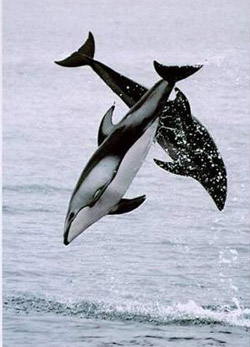 Dolphins are of the aquatic mammal family Delphinidae. It is estimated there are between 30 to 40 species of dolphins.
Dolphins are of the aquatic mammal family Delphinidae. It is estimated there are between 30 to 40 species of dolphins.
- Dolphins can swim and sleep at the same time. For 8 hours, the entire brain is awake. The left side then sleeps for 8 hours. When it wakes up, the right side sleeps for 8 hours.
- Dolphins are capable of imitation and memorization.
- The common dolphin averages 2.5 m in length and 74 kg in weight.
- A dolphin's flipper has five digits and nearly the same bone structure as a human arm and hand.
- A dolphin's can detect underwater sounds from 15 miles away.
- Dolphins are fishlike in form, with streamlined, hairless bodies.
- Dolphins jump out of the water to conserve energy.
- The best known species are the common dolphin (Delphinus delphis) and the bottle-nosed dolphin (Tursiops truncatus).
- As early as 340 B.C. Aristotle considered dolphins and related creatures to be mammals.
- A dolphin can remember a specific tone far better than can a human.
- Fish and squid are the diet of the common dolphin, where the dolphins have been seen hunting and working together to herd the fish into tight balls.
- Dolphins produce an enormous variety of sounds, up to frequencies ten times those heard by human beings.
- Like a bat, dolphins use echolocation to navigate and hunt, bouncing high-pitched sounds off of objects, and listening for the echoes.
-
An excerpt from the World Wildlife Fund (2005) concerning the order Cetacea, which includes both whales and dolphins: "The greatest threat to whales, dolphins and porpoises is entanglement in fishing gear, also known as bycatch. If current trends continue unabated, several cetacean species and many populations will be lost in the next few decades."
- Because the spinner dolphin swims with the yellowfin tuna, they have been slaughtered by the hundreds of thousands in the purse-seine tuna fisheries, which has produced the controversy that led to the enactment of national and international laws for dolphin safe tuna.
- Dolphins are mammals; they nurse their young from mammary glands and feed them with milk from the mother.
- Baby dolphins are sucked forward by the motion of their swimming mothers -- giving them a needed assist -- when they position themselves to the right and behind their mothers.
- Dolphins can swim up to 260 m. below the surface of the ocean, although they are mainly shallow divers and they remain close to the surface.
- Dolphins can stay up to 15 minutes under water although they usually stay only a few minutes diving before they go up to breathe.
- Dolphins are social beings which live in groups and cooperate among each other for activities like getting food and calf rising.
- There are 32 species of ocean dolphins and 5 species of river dolphins.
- The largest dolphin is the "killer whale" (orca), which can grow to 6.1 meters long.
- The most known dolphin is the "bottlenose dolphin" which can grow to 2.5-2.8 meters.
- Dolphins are warm-blooded and their internal temperature is around 36 degrees. To conserve this temperature they are surrounded by a thick layer of fat called "blubber" just below the skin.
- The average botllenose dolphin brain weighs 1500-1600 grams, while average human brain weighs 1200-1300 grs. This is not a conclusive evidence of dolphin intelligence as many other factors might be the cause of intelligence according to scientists.
- Dolphins can make a unique signature whistle that may help individual dolphins recognize each other or perform any other kind of communication still unknown.
- Bottlenose dolphins can swim 5 to 12 kilometers per hour, although they can reach up to 32 km/h.

References;
